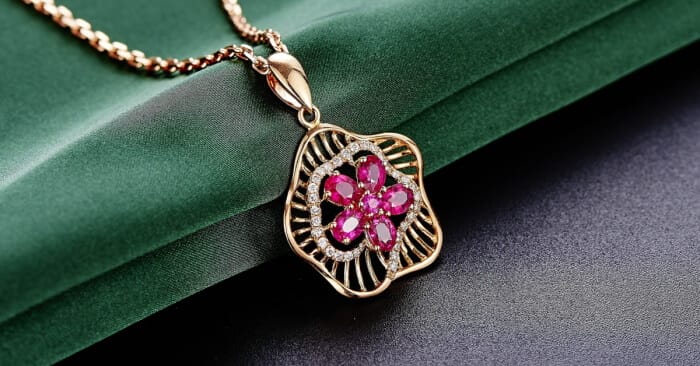Few gemstones are as eye-catching and coveted as a stunning red ruby. The name ruby comes from the Latin word ruber, meaning red – the color of love, passion, and desire.
Rubies often achieve the highest sales prices of colored gemstones. It’s one of the three traditional color (green, red, and blue) gems for emeralds, rubies, and sapphires, respectively.
It’s a variety of the corundum mineral family. Known for its hardness (second only to diamonds), it scores a 9 out of 10 on the Mohs Hardness Scale.
In addition to being the birthstone for July, a ruby is a traditional gift for 15-year and 40-year wedding anniversaries.
Read on to learn more about this precious gemstone, its history, and why rubies are so sought-after. If you’re thinking about pawning, selling, or buying rubies or ruby jewelry, you’re at the right place. We trust you’ll find this beginner’s guide to rubies useful and informative.

Where Are Rubies Mined?
According to the American Gem Society, rubies are mined in Myanmar (Burma), Afghanistan, Australia, Cambodia, India, Madagascar, Malawi, Mozambique, Pakistan, Sri Lanka, Tanzania, Thailand, the United States, and Vietnam.
Most fine rubies come from Myanmar and Mozambique.
A Short History of Rubies
Myanmar (formerly known as Burma) is the oldest recorded source of rubies, dating back more than five hundred years. In India, it was referred to as the “king of precious stones” – associated with the life force (similar color to blood), power, and energy.
Through the centuries, different cultures attached different meanings to rubies. Some examples of legends and folklore given by the Gemological Institute of America (GIA) include:
- Can be used to predict misfortune or danger
- Cures inflammatory diseases and soothes anger
- Burmese warriors believed it made them invincible in battle
- Medieval Europeans believed rubies bestowed health, wisdom, wealth, and success in love.

Rubies often appear in engagement rings or wedding anniversary bands.
The 4Cs of Rubies
All gemstones are evaluated based on the 4Cs – color, clarity, cut, and carat (weight).
Color
Rubies get their color from trace amounts of chromium included in the mineral corundum. The more chromium, the redder the ruby appears. Although many people believe that all rubies are bright red, they come in a range of reddish colors – pinkish-red, orangish-red, purplish-red, etc.
The finest, rarest, and the most sought-after color is a deep red with a hint of purple, commonly referred to as a “pigeon blood” color by dealers.
As the color becomes more purplish, pinkish, or orangish, the less desirable (and cheaper) the ruby becomes. If you’re looking at buying rubies, aim for a vivid red color that’s not too dark or too light.

Clarity
Very few rubies are transparent and have hard to find inclusions. The value of a ruby depends on how visible the inclusions are. The number, type, size, and location of inclusions all affect the transparency of rubies.
Cut
A ruby’s cut depends on its crystal structure, inclusions, and how a cutter incorporates them.
Carat
Fine jewelry quality rubies over one carat are scarce. The price per carat goes up exponentially as carat weight increases.
For example, all else being equal, a two-carat ruby is worth more than double two one-carat rubies combined.
Other Considerations
Heat Treatment
Over 97% of rubies are treated (mostly heat-treated) to enhance their color and clarity. All else being equal, an untreated ruby is typically worth twice as much as a treated one. It’s justified considering how seldom you’ll find an untreated ruby of the same quality.
Note that rubies that have had color diffused into the surface or fractures filled with lead glass to improve their appearance are worth less than heat-treated ones.
Federal Trade Commission
Before buying a ruby, always ask if it has been treated and what method was used.
The Federal Trade Commission (FTC) requires the disclosure of treatments that affect a gemstone’s appearance and value:
“Even if a gemstone treatment is permanent and doesn’t create special care requirements, you should tell consumers about the treatment if it significantly affects the value of the gemstone.”
When in Doubt
The Gemological Institute of America (GIA) can evaluate rubies and issue a GIA Colored Stone Report. According to the GIA:
“GIA colored stone reports describe the type of gemstone, if your stone is natural or synthetic, and if there are any detectable treatments. When determinable, origin will be provided for certain stones. Included in all reports is the gemstone cutting style, shape, weight, measurement, color and a photograph of the stone. Multiple security features on GIA colored stone reports ensure their authenticity. Loose or mounted gemstones may be submitted for these services.”
How to Clean Rubies
Use warm soapy water and a soft brush to safely clean rubies.
Note that rubies that have had color diffused into the surface or fractures filled with lead glass should only be cleaned with a damp cloth.
That's a Wrap
Rubies are likely, besides diamonds, the most sought-after, valuable, and rare precious gemstones. Owning a beautiful specimen is special, whether it’s a loose stone or set in jewelry.
We trust that after reading this beginner’s guide to rubies, you have a better understanding and appreciation of this remarkable gem.
If you have any questions or want to buy, sell, or pawn loose rubies or ruby jewelry, don’t hesitate to contact Maxferd. Our in-house experts stand ready to assist you.
Call us at (800) 888-7296 or visit one of our pawn shops in Los Angeles or our San Francisco pawn shop to find out how we can help you.

